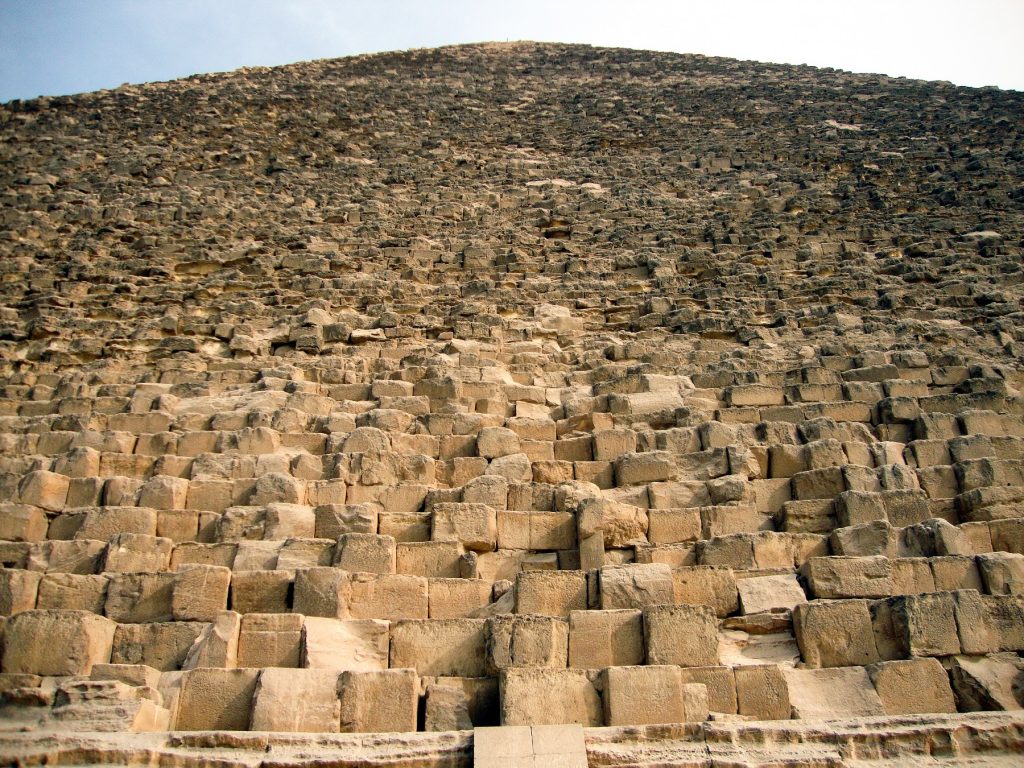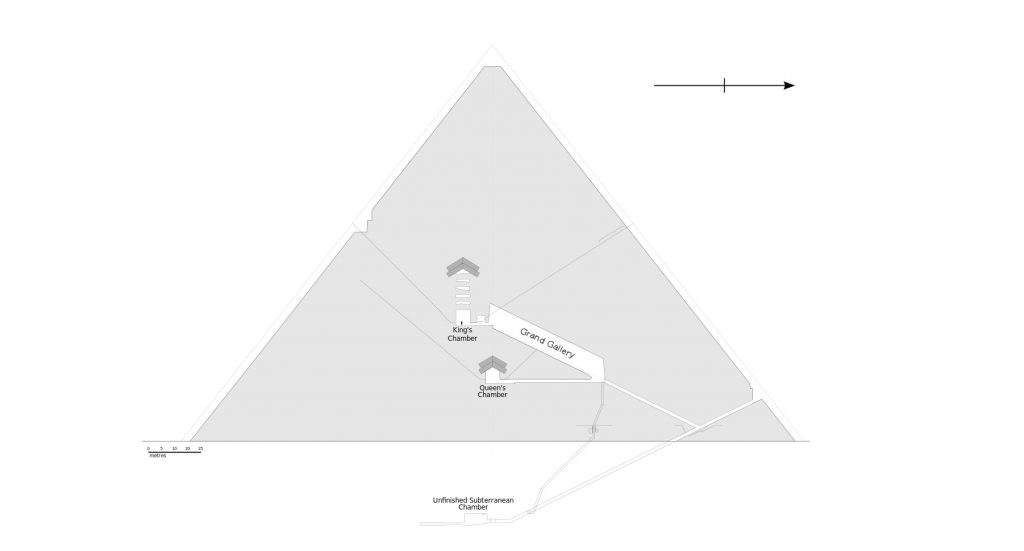- The Great Pyramid of Giza is one of the most accurately built structures on the surface of the planet: its orientation is 3’6” off true north.
- The pyramid was built with an estimated total volume of 2,583,283 cubic meters (91,227,778 cu ft). With an estimated total weight of 6.5 million tons, it is one of the heaviest manmade structures on Earth.
- When completed, the pyramid rose to a height of 146.7 meters. However, lacking its summit, the pyramid stands at 138.8 meters (455 ft) today.
- Although there are no written records of the pyramid being built, Egyptologists estimate it was commissioned by King Khufu during ancient Egypt’s Fourth Dynasty, around 2580–2560 BC. This theory is backed up by very few conclusive pieces of evidence.
- The Great Pyramid remained the tallest manmade structure on the surface of the planet for more than 3,800 years after it was built.
- It is the only known pyramid in Egypt with both ascending and descending passages.
- Despite being thousands of years old, and despite the fact the pyramid has been surveyed and studied for centuries, there are still mysteries hiding deep within it.
Of all the ancient Pyramids, none is perhaps as imposing as the Great Pyramid of Giza. Thought to have been built around 4,500 years ago as the eternal resting place for King Khufu, the Great Pyramid is Egypt’s most impressive pyramid. Despite the fact that millions of people around the globe refuse to acknowledge that the pyramids of Egypt were built as tombs, Egyptologists are convinced that these magnificent monuments were a direct evolution of the mastaba tomb.
Speaking of the debate about whether the pyramids of Egypt were tombs, not long ago I did an online survey about the pyramids and their purpose. I asked more than ten thousand people in a Facebook group if they thought the Egyptian pyramids were tombs.
Nearly eleven thousand people participated and less than five percent of people thought that pyramids were tombs. You can read about the internet survey here and see the results in detail.
“From the heights of these pyramids, forty centuries look down on us.”
—Napoleon Bonaparte
Stone in the Great Pyramid
The oldest of the seven wonders of the ancient world, the Great Pyramid of Giza is said to contain more stone than that used in all the churches, chapels and cathedrals built in England since the time of Christ. It is a structure of behemoth size: the builders used more than 2.3 million blocks of stone to build the Great Pyramid.
Furthermore, the Great Pyramid has an estimated total weight of around 6.5 million tons. To build the pyramid, Egyptologists say the ancient Egyptians used 5.5 million tons of limestone, 8,000 tons of granite (imported from Aswan, located around 800 kilometers away), and 500,000 tons of mortar.

Although there aren’t any records dating back to the time the pyramid was built, Egyptologists estimate that it took the builders no more than 20 years to build the pyramid. Experts believe that the Egyptians cut stones into rough blocks by hammering grooves into massive stone faces. They would then—supposedly—insert wooden wedges which were then soaked with water. As the wood absorbed the water the wedges expanded causing the stone to break off into smaller chunks that were then further worked on.
How exactly the stones were transported remains a mystery. The Egyptians transported some of their blocks using transport boats across the Nile. How the bigger stones were moved and transported from faraway quarries such as Aswan remains an archaeological enigma.
It has been estimated that once complete, the Great Pyramid of Giza was covered by as many as 144,000 casing stones. Each casing stone had a thickness of around 254 centimeters (100 inches). The casing stones of the Great Pyramid were nearly perfect: measurements have revealed that the stone’s flatness was around 1/100th or 0.01 inch of perfectly straight.
The Great Pyramid of Giza remained the tallest man-made structure on the surface of the planet for more than 3,800 years after it was built.
How did they do it?
Scholars have debated how the ancient Egyptians build the pyramids for centuries. The ancient Greeks believed that slave labor was used. Nonetheless, modern discoveries suggest that the Great Pyramid was built instead with the help of tens of thousands of skilled workers. Archaeologist Miroslav Verner posited that the labor was organized into a hierarchy, consisting of two gangs of 100,000 men, divided into five zaa or phyle of 20,000 men each, which may have been further divided according to the skills of the workers.
While that may have been the case and thousands of people participated in what was the greatest, most impressive construction project in history, it still remains a mystery as to how the stones were raised to such great heights, and what sort of tools were used by the ancient Egyptians who did not know of the wheel or pulley 4,500 years ago.
Planning is another mystery. However, some experts argue that the ancient builders of the pyramid may have used methods similar to those used in earlier and even later constructions: they would lay out the plan on the ground at a 1-to-1 scale. John Romer—a British Egyptologist—supports this theory and explains that “such a working diagram would also serve to generate the architecture of the pyramid with precision unmatched by any other means”
Evidence that ancient Egypt was very well organized in terms of resources and manpower can be seen more than one hundred years prior to the construction of the Great Pyramid of Giza when during the Third Dynasty reign of Pharaoh Djoser, the ancient Egyptians constructed the Pyramid complex at Saqqara. Nevertheless, many enigmas endure until this day. Despite countless archaeological excavations and surveys of the pyramids, we have not been able to fully understand how the pyramids were built.
Some sort of machines must have been used, and it is Herodotus who tells us in his 440 BC work “Histories” that this was in fact so. According to the Greek “father of History,” the ancient Egyptians made use of some sort of “wooden” machine (perhaps more than one) to raise some of the heaviest stones from ground level to great heights.
According to the Greek Historian:
The pyramid was built in steps, battlement-wise, as it is called, or, according to others, altar-wise. After laying the stones for the base, they raised the remaining stones to their places by means of machines formed of short wooden planks. The first machine raised them from the ground to the top of the first step. On this, there was another machine, which received the stone upon its arrival and conveyed it to the second step, whence a third machine advanced it still higher. Either they had as many machines as there were steps in the pyramid, or possibly they had but a single machine, which, being easily moved, was transferred from tier to tier as the stone rose — both accounts are given and therefore I mention both. The upper portion of the Pyramid was finished first, then the middle and finally the part which was lowest and nearest to the ground.
—Herodotus, Histories. 440BC.

Accuracy
As for accuracy, the Great Pyramid of Giza is on another level when compared to other pyramids around the globe. Although many other pyramids were built with great care, precision, and alignment, these features are exponentially greater at the Great Pyramid of Giza. The base is level to within just 2.1 centimeters (under 1in). The average deviation of the sides from the cardinal directions has been measured at 3’6” of arc. The greatest difference in the length of the sides is 4.4 centimeters (1.73in).
The ratio of the perimeter-to-height of 1760/280 Egyptian Royal cubits equals to 2π to an accuracy of better than 0.05 percent, which corresponds to the well-known approximation of π as 22/7. This incredible knowledge embedded within the structure has been claimed by some Egyptologists to have been confidential. Miroslav Verner explained that “although the ancient Egyptians could not precisely define the value of π, in practice they used it.”
In addition to that, the Great Pyramid of Giza is the only eight-sided pyramid in existence. This unique characteristic is not always visible, although experts have known about it for several decades. The eight sides of the pyramid are thought to have been spotted for the first time (in modern times) in 1940, when British Air Force Pilot P. Groves flew above the Giza plateau and noticed the concavity. The pilot even took pictures of the curious feature.
English Egyptologist I.E.S. Edwards wrote about the eight sides of the pyramid in 1975.
In the Great Pyramid, the packing-blocks were laid in such a way that they sloped slightly inwards towards the center of each course, with a result that a noticeable depression runs down the middle of each face — a peculiarity shared, as far as is known, by no other pyramid
—The Pyramids of Egypt, 1975, p. 207 I.E.S. Edwards
The exact reason behind such phenomenal exactness remains debated and unanswered. As explained by Lehner, such precision may have been imbued with symbolic and cultist significance that now eludes us.
However, this mind-boggling precision may also be a tell-tale sign that the pyramid may have served a higher purpose. What this purpose was, remains a complete mystery. To this date, and despite countless studies, surveys and research, many people around the globe continue to wonder whether the Egyptian pyramids may have been more than just ordinary, ridiculously expensive tombs for the kings (and eventually queens) of Egypt.
Inside the Great Pyramid

The Great Pyramid of Giza has four known interior chambers (and the Grand Gallery) of which three can be accessed. Its original entrance is located to the north, some 17 meters above ground level, around 7.3 meters east of the centerline of the structure. The original entrance is connected to a descending passage that is around a meter high, and just over one meter wide. It goes downwards into the pyramid and leads into the bedrock atop which the pyramid was built. After around 100 meters, the tunnel becomes leveled and opens to a smaller passage of around 9 meters, ending in the lower chamber.
Above that, we find a room incorrectly dubbed as the Queen’s chamber. Located between the northern and southern faces of the pyramid, this room measures 5.75 meters (18.9 ft) north to south, 5.23 meters (17.2 ft) east to west. The north and south walls of the Queen’s chamber have shafts which, unlike those in the King’s chamber do not slope immediately upwards, but rather continue horizontally before doing so. The shafts inside the Queen’s chamber are not connected to the outside of the pyramid. At the end of these particular structures, researcher Waynman Dixon found a circular object made of black diorite and a bronze artifact of unknown purpose in 1872.
The Kings Chamber is perhaps the most famous room inside the pyramid, and it is there where Egyptologists say that Khufu’s body was laid to rest after his mummy was prepared for the afterlife. This curious chamber, however, is left completely undecorated and seems cold and unworthy of a king who commissioned and built a pyramid the size of the Great Pyramid. Unlike other rooms within the pyramid, the King’s chamber has two narrow shafts in the north and south walls whose exact purpose is not clear, although they may be aligned towards the stars or certain regions of the northern and southern skies.
The Grand Gallery is perhaps the most impressive internal structure of the pyramid. It continues the slope of the ascending passage. It features a corbelled roof, similar to those seen in many other ancient Egyptian pyramids. The structure is roofed by stone slabs with a slightly steeper angle than the floor of the gallery. Most curiously, the Grand Gallery’s floor is made up of a step on either side, measuring around 50 centimeters wide. 54 slots, 27 on each side exist and are matched by vertical and horizontal slots in the walls of the Gallery. When connected, they form a curious cross shape that rises out of the slot in the shelf. The exact purpose of this feature remains another enigma of the pyramid’s interior.
In addition to the Subterranean chamber, the Queen’s Chamber, the King’s Chamber, and the Grand Gallery, in 2017 a scientific mission called ScanPyramids discovered a massive, previously unknown void within the pyramid. The cavity was found using muon radiography. The void is around 30 meters wide and has a cross-section similar to that of the Grand Gallery. The existence of the void has been confirmed by three independent studies. The exact purpose of the Big Void remains a mystery, and so does its interior.
My take on the Great Pyramid
As Ahmed Fakhry put it in his work “The Pyramids,” if you ask a world traveler which famous monuments made the strongest impression on him he would probably reply “the pyramids of Giza.” For some, it is because of their immense size, for others their incredible accuracy and elegance, while some would say their antiquity and mystery. For me, it is all the above combined that gives the pyramids of Giza—and especially the Great Pyramid—a sense of wonder.
I have long been left perplexed by the magic the pyramids irradiate, and the Great Pyramid of Giza has been in some sense a star around which all other pyramids orbit. Although the Great Pyramid of Giza is not the largest on the surface of the planet, and despite the fact it may not be the oldest, it has that something “special” that makes it far more unique than any other pyramid on Earth. That’s why whenever the pyramids are mentioned, that of Khufu—the Great Pyramid—comes to mind.
In my personal opinion, I highly doubt that the many precise measurements embedded within the Great Pyramid were a random feature. I also do not believe that the builders of such a marvelous, unprecedented structure left anything to chance. That’s why I fully agree with Petrie who explained that “the relations of areas and of circular ratio are so systematic that we should grant that they were in the builder’s design.”
Although I also believe that the Pyramids of Giza were very much human monuments, I feel that their true purpose continues eluding us. While Egyptologists maintain these majestic structures were tombs for the pharaohs of Egypt, I can’t help to wonder if they may have served a far greater purpose. I also can’t help wonder why there are so many pyramids of similar design around the world, and why so many ancient civilizations built pyramids in the first place?
In 2017, a group of scientists published a revolutionary study concerning the Great Pyramid of Giza and electromagnetic energy. Had you put those three words in the same sentence over 20 years ago, Egyptology would probably have called you a lunatic. However, scientists from ITMO University (Russia) and the Laser Zentrum Hannover (Germany) discovered that “in the resonant state, the Great Pyramid was able to concentrate electromagnetic energy inside its chambers but also well beneath its base, where an unfinished chamber is located.”
Using multipole analysis, the scientists confirmed that the scattered fields concentrated inside the Pyramids chambers as well as beneath its base.
While this was a fascinating study that shed new, refreshing light on the purpose of the Great Pyramid, the scientists behind the study conclude that although this discovery is fascinating, the people who built the pyramid were probably unaware of this fact.
But what if they were not unaware of this? What if we are discrediting the capabilities and knowledge of ancient civilizations? What if there is a higher, greater purpose to the pyramid? And what if all the discoveries that have been made in recent years are just small signs that prove there is more to the pyramid than initially thought?
I wouldn’t agree with Miroslav Verner who suggests that the ancient Egyptians could not precisely define the value of π, although in practice they used it. I also don’t think that the people who built the Great Pyramid left anything to chance. They built a structure with more than 2.,34 million blocks of stone. They moved multi-ton blocks of stone across hundreds of kilometers.
They moved these blocks of stone by means that elude us to this date. They created a pyramid with an estimated total weight of 6.5 million tons, and a total volume of 2,583,283 cubic meters (91,227,778 cu ft). It was the tallest structure for more than 3,800 years, and you want to tell me that they left things to chance?
I think the Egyptians—who were excellent engineers, mathematicians, and astronomers—knew exactly what they were doing when they planned, designed and built the Great Pyramid of Giza. I think that everything we are beginning to discover about the Great Pyramid of Giza is just a small piece of a greater puzzle that we have still not completely uncovered. I think that calling the pyramids of Egypt only tombs for the Pharaohs, despite the fact, their interiors are cold, undercoated and unworthy of kings is an insult to the capabilities and intelligence of ancient civilizations such as that of Egypt.
Yes, the pyramids may have been very human monuments, but let us not diminish their importance by trying to forcibly give an answer to questions that elude us. Let us not try to claim we know everything there is about the pyramids when new surveys prove there is much to learn. Let us not claim we know everything there is to know about the pyramids until we can accept, for a moment, that their purpose may very well go beyond our current understanding.
Without written records, and without a machine that would allow us to travel back in time to when the pyramid was built, we cannot say for certain we know everything there is to know about the Greatest most impressive pyramid built in the history of humankind.

